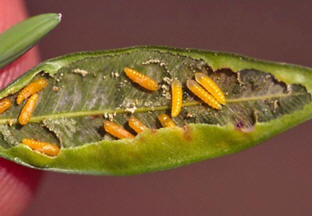Boxwood Leafminer
 DESCRIPTION
DESCRIPTION
Boxwood Leafminer is considered to be the most serious pest of Boxwoods. All varieties are susceptible, however, the slower-growing English varieties are less likely to be attacked than most other varieties.
LIFE CYCLE
The Boxwood Leafminer overwinters as an immature yellow larva in the leaf blisters. When the weather warms up in the spring, the larva becomes active, grows rapidly and then pupates. The pupa darkens prior to adult emergence. As the adult emerges, the pupal skin is forced partially out of the mine where it hangs for several days after the fly leaves. Adults appear for about a 2 week period after Boxwoods put on new growth in the spring. Females soon begin inserting eggs into the leaves. Eggs hatch in about 3 weeks. Larvae begin their mining activity in the leaves.
 DAMAGE
DAMAGE
This pest mines in the foliage by feeding between the upper and lower leaf surfaces. Mining activity results in the formation of small blisters on the undersides of the leaves. Infested leaves turn yellowish and are smaller than uninfested leaves. The infected leaves eventually drop prematurely. Heavily damaged plants become unsightly and sparse in appearance.
CONTROL
In late winter or early spring, Imidacloprid can be applied as a soil injection or drench around the shrubs. This systemic insecticide provides good control against the new leafminer larvae occurring in May. Annual treatments may be necessary.


